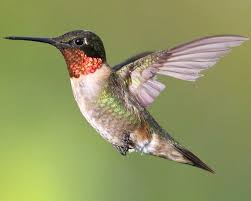This article was written by one of our summer interns, Kayla Walsh. The below photo is a Ruby-throated hummingbird.
 A flash of green iridescence swoops by with an audible hum. The ruby-throated hummingbird has discovered a feeder! She zips back and forth to guard her newfound food source. These jewel-throated warriors will dart at bees, other hummers, and even large birds like crows. August in Wisconsin is a prime time to observe hummingbirds near feeders as they prepare for their long migration south. On average, hummingbirds weigh less than a nickel (4.5 grams). They might be tiny, but they are mighty.
A flash of green iridescence swoops by with an audible hum. The ruby-throated hummingbird has discovered a feeder! She zips back and forth to guard her newfound food source. These jewel-throated warriors will dart at bees, other hummers, and even large birds like crows. August in Wisconsin is a prime time to observe hummingbirds near feeders as they prepare for their long migration south. On average, hummingbirds weigh less than a nickel (4.5 grams). They might be tiny, but they are mighty.
Of the 325 different species in the world, Manitowoc County hosts the Ruby-throated hummingbird, which will migrate south in early fall. They fly up to 500 miles nonstop at 30 miles per hour across the Gulf of Mexico to winter in Central America. Hummingbirds beat their wings up to 2000 beats per minute, so their bodies must be powerful. Their flight muscles comprise 30% of a hummingbird’s total weight. In comparison, their feet are weak and tiny. This is an adaptation to make them lighter and thus, more efficient fliers. A hummer’s heart beats 250 times per minute while resting and 1200 beats per minute while flying and feeding.
With such speed and endurance, it’s no wonder that hummingbirds have the 2nd highest metabolism in the animal kingdom. Therefore, they must feed every 10-15 minutes, sometimes visiting over 1000 flowers per day. Hummingbirds see in near-UV vision, so the colors red and green catch their eye. This is why hummingbird feeders are usually red. Hummers extend their hairy tongues into succulent flowers and use capillary action to absorb the nectar (like a paper towel absorbs water). They then retract their tongues in a lapping motion, like a dog or cat. They can lap up to 13 times per second! With a brain that comprises 4.2% of its body weight, a hummingbird can recall each flower it visits and how long it takes to refill with nectar.
Hummingbirds are actually carnivores. They lap nectar, but also eat insects for protein. They consume flies, gnats, mosquitoes, and aphids, eating up to one half of their body weight every day. In addition, they drink up to 8 times their body weight in nectar! If it’s time to migrate, they can eat up to 10 times their mass each day- about 14,000 calories/kilogram.
To conserve this hard-earned energy at night, hummers can enter a torpid state. Hummingbirds are able to cling upside down to a branch and hang limp. Body temperature drops, and heart rate and metabolism slow significantly.
Hummingbirds enter this torpid state more often during mating and migration seasons. When she’s ready to mate, a female will first build a walnut-sized nest out of lichens, lined with soft seeds and fur. Commonly, the nest is well attached to a high branch with spider silk. The female will lay two eggs, each fertilized by a different male. Males take no responsibility in rearing the young. When chicks fledge, they are larger than their mother, who has lost significant weight while rearing them.
Hummingbirds are strong, talented, fliers who’ve captivated humans for centuries. Hummers are revered in Native American legends as symbols of regeneration and resurrection, or as creatures who appreciate the magic of the present moment. However, these beautiful creatures are threatened by habitat destruction along their migration routes. You can help keep this symbol of regeneration healthy by putting out a hummingbird feeder in your yard! Watch the iridescent, ruby-throated hummingbird dart and sip, and wish her good luck in her impending migration.
